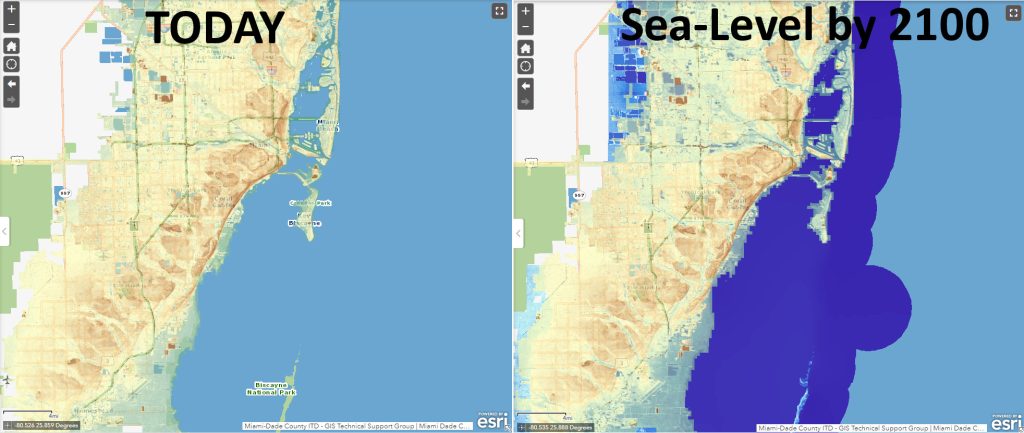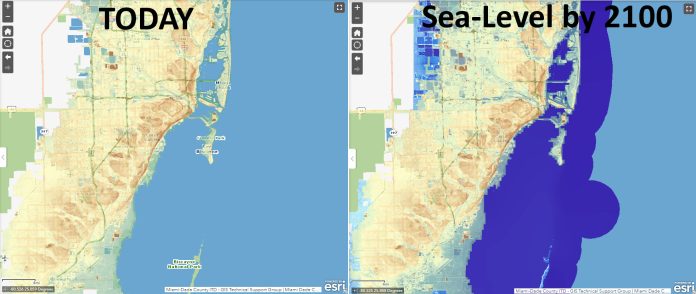By Sterling Burnett and Anthony Watts
A recent debate in The Nation claimed Miami should either make plans to evacuate from the Florida coast or become the model of adaptation in response to rapidly rising sea levels from climate change and the refugees that will result from it. The story is not just false, it is laughably inept. There is no evidence the United States faces the loss of any major coastal city due to climate change or that climate change has or will create climate refugees.
The Nation published an exchange between by Daniel Aldana Cohen and Samantha Schuyler titled “Should We Start Preparing for the Evacuation of Miami?”
Cohen, an assistant professor of sociology at UC Berkeley, premises his whole argument for abandoning Miami on the claim that, like residents, refugees arriving there will soon have no place to live, with evacuation setting a good example for other cities, writing:
It’s urgent for governments and social movements to start planning for millions of people to land in new places. Prepping Miami’s evacuation is a perfect starting point. Its residents are a multiracial, multinational, and multigenerational assemblage that spans the class spectrum. Tragically, many of them are already climate migrants—like Puerto Ricans displaced by recent hurricanes.
If cities around the country were forced to plan how they’d integrate arriving Miamians into communities flush with public green investment, they’d get a head start on planning for climate migration generally. This would also trigger conversations about zoning for density, enshrining tenant rights, upgrading infrastructure, taxing the rich, building green banks, and battling racism and police violence.
Throughout his article, Cohen references non-scientific concerns like emancipation, the “Great Migration,” environmental injustice, and apartheid. The only thing missing from Cohen’s argument were actual facts and data providing evidence for the need to withdraw from Miami or that climate refugees are or will become a problem.
Addressing Cohen’s climate refugee concerns first, as explored here and here, neither hurricane frequency nor intensity have increased during the period of modern warming. So worsening hurricanes won’t drive people to abandon Miami, or drive people from islands near Miami to the U.S. mainland. As to the climate refugees Cohen believes are already trickling into to Miami, which he believes will soon become a flood, it turns out he is wrong again. Not a single climate refugee has been proven, as discussed at Climate Realism, here, nor is there reason to believe the United States or any other country is about to be swamped by climate refugees, as discussed here and here.
To The Nation’s credit, Cohen’s article has a counterpoint response from Samantha Schuyler, The Nation’s own research director. Unfortunately Schuyler’s response is only slightly less alarmist.
“At some point, if South Florida doesn’t change its approach to navigating climate change, evacuation will be necessary,” Schuyler writes. “But by withdrawing from Miami too soon, we will lose a vibrant city that could have become a training ground for learning how to adapt to the planet’s future.”
As discussed in numerous Climate Realism articles, here and here, for instance, there is no evidence whatsoever seas are rising at an usually rapid rate.
NASA satellite instruments, measuring sea-level since 1993, show global sea level rising at a pace of 1.2 inches per decade. As shown in Climate at a Glance: Sea Level Rise, this is approximately the same pace of sea-level rise that has occurred since at least the mid-1800s. Moreover, there has been little or no acceleration in sea-level rise during recent years.
The National Oceanic and Atmospheric Administration (NOAA) maintains a tidal gauge just offshore from Miami on Virginia Key. The NOAA Virginia Key tidal gauge shows sea level at Miami is rising even more slowly than the global average of 1.2 inches per decade, as seen in Figure 1 below. Miami, shows no signs of acceleration in sea level rise.

So, if sea-level rise is slower that the global average, showing no signs of acceleration, what is driving Cohen’s and Schuyler worry that Miami may soon be uninhabitable?
At the core of Cohen’s and, to a lesser extent, Schuyler’s concern about climate change swamping Miami are flawed computer models and actual land subsidence.
Cohen and Schuyler have seemingly joined other pop-culture climate analysts to embrace worst-case scenarios generated by computer climate models about the future. However, in a recent report, some climate scientists are putting the brakes on future warming and say other researchers should avoid suspect climate models. This research confirms what Climate Realism first reported in August 2021, the climate model Representative Concentration Pathway 8.5 (RCP8.5) produces “implausibly hot forecasts of future warming.”
Without the worst-case scenario, sea-level rise predictions are dialed back. The one piece of evidence that Cohen did cite to make his case for rapidly rising seas is the Miami-Dade County Flooding Vulnerability Viewer, a computer mapping tool for Miami showing what the future might look like with sea-level rise. Yet even this evidence fails to support Cohen’s claims. By doing a side-by side comparison, shown in Figure 2 you can see for yourself that Miami isn’t in need of “evacuation” at all.

Miami’s real problem isn’t rising seas as much as land subsidence. Much of Miami was built on reclaimed swamp land, and then built up with modern infrastructure. That extra weight causes a sinking of the land, known as subsidence, allowing seawater to seep in when the surfaces sink to near sea-level. It also means that during strong rainfall events, and hurricane storm surge, areas that have subsided don’t drain as they did years before.
This is clearly covered in the scientific paper Land subsidence contribution to coastal flooding hazard in southeast Florida, published in Proceedings of IAHS in 2020. The paper clearly states:
Preliminary results reveal that subsidence occurs in localized patches (< 0.02 km2) with magnitude of up to 3 mm yr−1, in urban areas built on reclaimed marshland. These results suggest that contribution of local land subsidence affect only small areas along the southeast Florida coast, but in those areas coastal flooding hazard is significantly higher compared to non-subsiding areas.
Subsidence is also driven by freshwater withdrawals from the region’s groundwater reserves to satisfy the Miami metro area’s growing population.
So, just as the Figure 2 comparison shows, “only small areas along the southeast Florida coast” are affected, and Miami itself is hardly in need of evacuation.
Climate activists such as Cohen and his media regurgitators at The Nation are simply making up claims and counting on nobody fact-checking them to point out their lies as has been done here. It is an indictment of the shoddy state of journalism today.

















